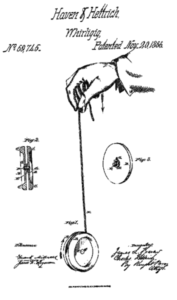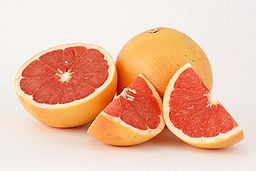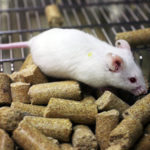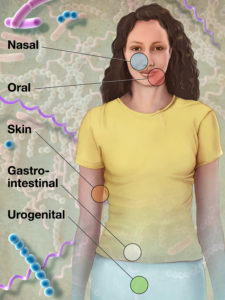Yo-Yo Dieting: Blame Microbiome and Fewer Flavonoids
Today begins phase 1 of the holiday season, with eating, eating, and more eating. Then comes phase 2, on January 2. Hordes of the sedentary suddenly swarm exercise classes and take over the treadmills. Diets begin. But it’s back to normal by mid-February.
 The poster woman for yo-yo dieting is Oprah Winfrey, who in 1988 famously hauled a red wagon full of glistening fat onto the stage of her talk show, representing the 67 pounds she’d lost on Optifast over a few months. Two weeks after stopping, she’d gained back the first 10 of many pounds to come.
The poster woman for yo-yo dieting is Oprah Winfrey, who in 1988 famously hauled a red wagon full of glistening fat onto the stage of her talk show, representing the 67 pounds she’d lost on Optifast over a few months. Two weeks after stopping, she’d gained back the first 10 of many pounds to come.
Today a report in Nature from Eran Elinav and Eran Segal from the Weizmann Institute of Science and colleagues tracks how the intestinal microbiomes of obese mice change as they cycle between “normal chow” and a “high-fat diet,” their weights oscillating in sync to the shifts. Control mice consumed only high-fat food, only regular chow, or they cycled just once. As was true for Oprah, weight loss paradoxically exacerbated the ability of the mice to keep it off post-diet. (I’m not sure why the researchers used high-fat and regular chow, rather than regular chow and low-calorie chow — seems that would be more like what people eat.)
I usually ignore mouse studies, but this one has a helpful and easy-to-implement tip for humans caught in a post-holiday caloric stupor.
CLUES IN A CHANGING MICROBIOME
The microbiome is the collection of microorganisms and viruses that reside in and on the human body. I’ve written about the microbiome in human stool, on the penis, and in the vagina. Microbiome residents are identified by their DNA. And microbiomes can be transferred from one individual to another in fecal transplants, which is much easier than introducing DNA using gene therapy or genome editing.
The new study reveals that lingering effects of the obesity-associated microbiome may lie behind the yo-yo effect. The researchers identified 773 bacterial genes overrepresented when the mice ate fatty food that remained overabundant when regular chow resumed. Genes involved in the synthesis of plant compounds called flavonoids in particular became depleted after bouts of obesity.
Cycling was actually worse than eating fatty food all the time, slowing calorie burn and elevating total body fat, leptin, and LDL, but not raising HDL.
ZEROING IN ON FLAVONOIDS
The researchers used fecal transplants to get to the bottom of the yo-yo effect. Transferring feces from obese mice into skinny mice with pristine guts made the clean mice gain weight — but only if they ate fatty food.
Next the investigators discovered which types of bacteria make weight gain more or less likely. And fortunately for us, they examined how the altered microbiome affects the nutrients present, saving us from the need to follow successful dieters to the bathroom and DIY. I’m ok with fecal transplants to treat Crohn’s disease, but for weight control, not so much.
The high-fat mouse diet particularly depleted flavonoids apigenin and naringenin. And supplementing the diet with both reversed the yo-yo weight gain!
Luckily, “postbiotic” supplements are already available, right on Amazon – apigenin and naringenin. Maybe I’ll scoop some up on black Friday. I imagine they’ll soon be repackaged, renamed, and the price hiked.
 Implicating flavonoids is consistent with dieting lore. Apigenin is in parsley, artichokes, and celery, and aren’t we told to eat celery because it takes more calories to digest than it provides? Naringenin is in citrus, especially grapefruit. Remember the grapefruit diet? I love when convoluted scientific experiments validate what regular people have learned through trial and error.
Implicating flavonoids is consistent with dieting lore. Apigenin is in parsley, artichokes, and celery, and aren’t we told to eat celery because it takes more calories to digest than it provides? Naringenin is in citrus, especially grapefruit. Remember the grapefruit diet? I love when convoluted scientific experiments validate what regular people have learned through trial and error.
HALTING THE YO-YO EFFECT: DON’T DIET!
The real reason behind yo-yo post-diet weight gain is clear from the language of today’s report, but not addressed: the mice had “recurrent post-dieting obesity”. The problem is the POST.
Find a nutritional plan – not a temporary diet – that works, and stick to it. Forever! I did.
I was a skinny kid, even requiring a doctor’s note for double lunches at summer camp. Much later, when I had trouble losing post-pregnancy weight, I tried the grapefruit and cabbage soup diets, lasting a day on each with no effect other than a terrible mood. But in 2004, I noticed that having 3 kids had put on the pounds. (I’ve always exercised about an hour a day.) I had to finally take my flab in hand and do something.
Rather than watching talk shows and reading magazines, which pushed low-fat (see below), I turned to my knowledge of biochemistry. And I knew that the diet most likely to work would be low-carb.
Here are some unrelated facts that led to the way of eating that has enabled me to take off and keep off about 40 pounds:
• OBSERVATION: It’s easy to eat a huge plate of pasta, or even two, but not a plate of pork chops or steak. So even though gram-for-gram fat has more than twice the calories of carbs or proteins, it’s hard to consume much of it. Satiety prevails.
• BIOCHEMISTRY: Carbs hike triglyceride levels and digested triglycerides form lipoproteins such as LDL. The carbohydrates are broken down and the pieces reassembled into the building blocks of triglycerides — it isn’t as if the macronutrients in food stay exactly that way. They’re digested and the chemical components react.
 • GOVERNMENT: In the 1970s, the USDA began promoting carbs, even high fructose corn syrup, along with a low-fat diet. “Lowering the Bar on the Low-Fat Diet,” in this week’s JAMA, calls it “the largest public health experiment in history.” Over the ensuing decades, rates of obesity and diabetes shot up as we eschewed fat. Only the people reading Dr. Atkins’ diet books and those who understood biochemistry didn’t fall for this unchallenged mantra and realized that refined carbs are the real enemy. Yet even today, it’s harder to find low-carb products than low-fat ones. The stigma sticks, as people continue to drink the grape kool-aid of low-fat diets.
• GOVERNMENT: In the 1970s, the USDA began promoting carbs, even high fructose corn syrup, along with a low-fat diet. “Lowering the Bar on the Low-Fat Diet,” in this week’s JAMA, calls it “the largest public health experiment in history.” Over the ensuing decades, rates of obesity and diabetes shot up as we eschewed fat. Only the people reading Dr. Atkins’ diet books and those who understood biochemistry didn’t fall for this unchallenged mantra and realized that refined carbs are the real enemy. Yet even today, it’s harder to find low-carb products than low-fat ones. The stigma sticks, as people continue to drink the grape kool-aid of low-fat diets.
Medical journal articles have perpetuated the false dichotomy of low-fat vs low-carb diets, usually based on short-term evaluations. Here’s one that actually extended to a year.
MY PLAN
My eating plan is based mostly on the South Beach Diet with touches of Atkins and the Mediterranean diet, although that term might not have been around in 2004. Still, the value of monounsaturated fats like olive oil was well known.
 I also considered diets for people with diabetes, who limit or avoid the culprit white carbs. I invented a “low glycemic index soup/stew (LGIS)” simply by consulting the glycemic index list, which is a scale of 1 to 100 with glucose at the top. I selected some compatible ingredients, and here it is.
I also considered diets for people with diabetes, who limit or avoid the culprit white carbs. I invented a “low glycemic index soup/stew (LGIS)” simply by consulting the glycemic index list, which is a scale of 1 to 100 with glucose at the top. I selected some compatible ingredients, and here it is.
Not everything was obvious based on biochemistry though. For example, I learned that eating soy “bacon” every morning prevented absorption of synthetic thyroid hormone, to the point that my endocrinologist thought my cancer had come back! A strip or two of real bacon once or twice a week is better for me, and for those with hypothyroidism, than the healthier-sounding soy.
 I started my eating plan during a week when my husband was away – he eats a near-100% carb diet – so I could get through the initial South Beach phase without becoming homicidal. I survived, lost weight rapidly within the first 6 months, and have only gained back 4 pounds over the ensuing 12 years.
I started my eating plan during a week when my husband was away – he eats a near-100% carb diet – so I could get through the initial South Beach phase without becoming homicidal. I survived, lost weight rapidly within the first 6 months, and have only gained back 4 pounds over the ensuing 12 years.
Now thanks to the new study, I’ll be adding some flavonoids. And when I’m through with authoring textbooks maybe I’ll write a diet book!



[…] Source: Yo-Yo Dieting: Blame Microbiome and Fewer Flavonoids […]
[…] of the Lord. I simply observe that there is a lot of diet discussion this time of year, and so a new paper examining why dieting works and more significantly why it doesn’t work caught my eye. Yes, it involves the microbiome; turns out that Innerspace is the final frontier. […]